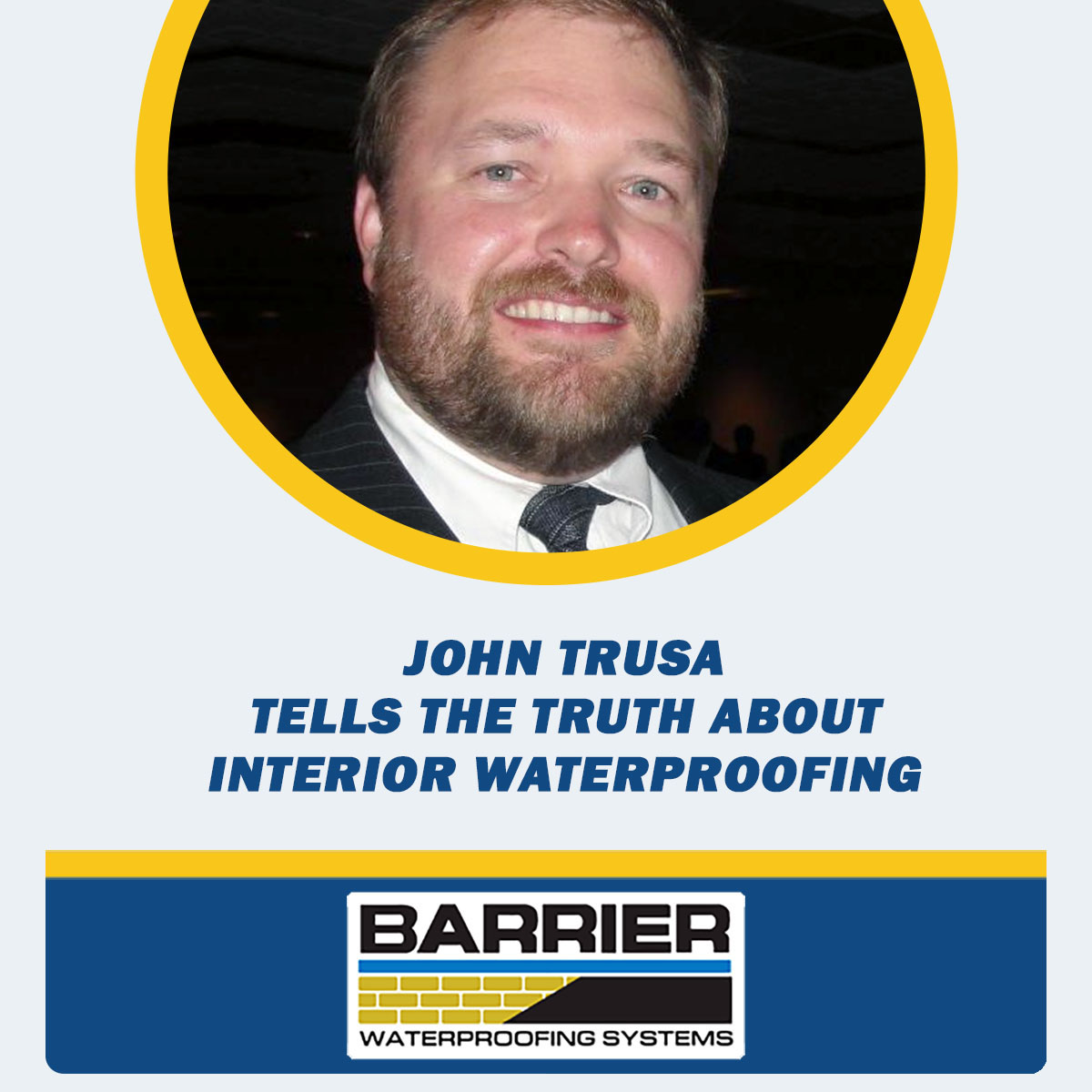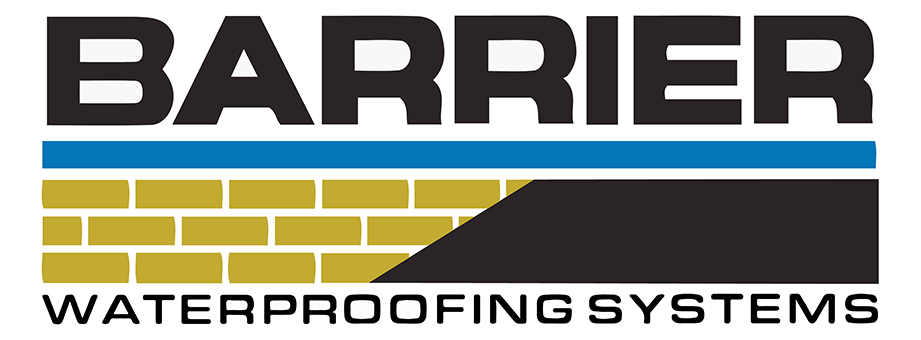Have you been considering the state of your home’s foundation? Perhaps you have been dealing with standing water in your crawl space or leaking water in your basement. Any cracking in your walls or concrete blocks alone is enough cause for concern!
The more information you know about the waterproofing services available to solve your problems, the more prepared you will be to make a wise choice with little to no compromise on the efficiency of the job. After consulting a specialist to evaluate your situation, the results could come back that you would be best off installing an entire extensive system or simply adding in a single drain. Whichever end of the scale you choose, you will want to be confident knowing that the work being done (and the price tag on it) is justified with good sense.
We turned to John Trusa, owner at BARRIER Waterproofing Systems, for a slew of information on all kinds of waterproofing systems, and good sense to boot! With over a decade of experience successfully preventing water from destroying countless foundations all across Middle Tennessee, we asked some questions that shed light on interior waterproofing services.
Right off the bat, he emphasized the fact that your foundation WILL BE affected if it is intruded by moisture.
“There are a lot of so-called waterproofers out there that will say your foundation can’t or won’t decay, but it’s not true. If the foundation gets wet, it is going to decay at some point.”
He continued to explain that time after time, he has witnessed homes dealing with the structural consequences. The situation can worsen when the water reaches, absorbs in, and sets on the foundation’s lowest level concrete blocks, causing them to deteriorate until it reaches the point of failure. By understanding the different waterproofing repair processes, customers can make informed decisions, Trusa says, and can help prevent future headaches.
“You want to get the water off [the foundation] as quickly as you can, better yet, keep the water from coming into contact with it in the first place. To do that, we would seal it from the outside. Then it will never get wet.”
While Trusa highly recommends Exterior Waterproofing services to create an impenetrable barrier around your foundation, he says that Interior Waterproofing services will also do the job to keep water off your home’s important structures. Simply put, the most effective method is to seal the foundation on the outside, while getting water off the foundation as quickly as you can with an interior system is second best.
An interior system allows water to pass through to the foundation and collect in a series of drains where it is pumped outside the home. Of course, if nothing is done about intruding water, you are going to be left with a deteriorated foundation that will cost a lot of money to fix.
“A lot of waterproofing guys won’t ever mention exterior sealing and waterproofing of a foundation as a potential fix to their problem. At Barrier Waterproofing, we offer interior systems as well as exterior solutions, and my customer will be informed and educated prior to making a decision. The guys that do this work solely on the inside know these homeowners have a good possibility of developing foundation issues by letting the water pass through the foundation. “But they all fix foundations, so they’re cool with it.”
Trusa highlights his take on performing foundation repair services with a disclaimer about how important he finds it to preserve the integrity of doing business, saying “We fix foundations too and I’m cool with it too, but I want to give my customers a chance to do it the right way.”
When asked about how often homeowners opt for the security of Exterior Waterproofing, he explained that Interior Waterproofing solutions are actually the most commonly chosen and why:
“Price. That is 100% of the reason why so many people don’t do the outside. If money were not an issue, everyone would have the work done on the exterior of their homes.”
He continued on to highlight the superior benefits of sealing your foundation from the outside, including making your money back “at a future point” when an exposed foundation would otherwise have already required expensive repairs.
“There are other benefits too. You’re keeping the foundation stable by keeping the water out. Water, when it passes by the piers and other structural components in the ground, like footers, will loosen and erode the supporting soils. A house will move around and settle when you have water flowing through it. Think about it.”
A stable home structure is reason enough to invest in an effective and reliable solution, however, unsightly issues that occur inside the home can also be avoided. Cracking drywall and cupping floorboards are telling signs of moisture intrusion on your foundation that can be avoided with Exterior Waterproofing services.
Shifting gears, we asked about homeowners that experience problems with crawl space water and basement leaks after having had some waterproofing measures implemented for their home. One popular method in Tennessee is Dampproofing. This method involves a tar substance being applied to the outer walls of the foundation during a home’s construction. When asked about the increase of complaints about its ineffectiveness, Trusa responded:
“Code in Tennessee still calls for Dampproofing. So many of these houses we see problems with have plain old tar on them. The tar only works for 2-4 years until all the acid in the rain and soil dissolves the solvents in the tar. Then water flows through the blocks like nothing was ever applied to the walls.”
He continued to state that most of the time Exterior Waterproofing services are applied in lieu of any presence of previous Dampproofing done on the home. Furthermore, his caution to homeowners about Positive Drains, another common fix suggested by waterproofing contractors, was this:
“A lot of these guys install these positive drains in where they can never properly work in the first place. They run a pipe through the concrete block from inside of the crawl space through the foundation wall and out to the yard and call it good. The positive drain cannot work without running the drain to daylight and with proper slope away from the home. Sometimes they run them to a buried pile of gravel in the yard and call it a drywell. But once the dry well is full, the water backs up into the crawl space and water sets on the foundation. Positive drains always start with great intentions but usually end up as a failure due to poor installation.”
Positive Drains can indeed be an effective solution in situations where water is intruding on your foundation, but it has to be done right and you have to have proper yard slope.
“First off, you need to have enough slope away from the home to move water. Slope will allow us to daylight our drains. We install our positive drains to take the water out right away so it doesn’t set on the block for an extended period of time. The point here is, the drain should go underneath the footing at a lower level than your foundation block. You shouldn’t let water pool up in a crawl space before you give it a way out.”
So just how badly can moisture affect your foundation? There was no doubt from Trusa about answering this question, and again it was emphasized that it is nothing to take lightly.
“You can do positive drains, you can do sump pumps, but somewhere in that process you need to get that water off of the block, off of the foundation, to keep it solid. As water passes through block, it slowly drags the minerals out of it. This eventually softens the block and promotes decay. We have come across foundations where we have been able to grab the block and pulverize it in our hands, there was no strength to it left.”
As dire as this situation may sound, there is still hope! Many companies like BARRIER also specialize in foundation repair, providing services to homes that have simply sat in moisture for far too long that waterproofing won’t cut it. There are various services that can restore the strength of your deteriorated foundation, even from the condition explained above.
Trusa recalls, “We had to manually clean off the footer below the eroded block. There was nothing solid left. We installed a temporary wood form at the footer level so core-fill wouldn’t run out. We cored out the block faces higher up on the wall to provide an opening to add rebar. We filled each block cavity with a portland cement mix. When it setup, it was like we had a new foundation.”
Even the wettest of foundations can be protected with an expert team from BARRIER Waterproofing Systems. They will evaluate your foundation and the different variables unique to your home to develop a plan that will work. With every day making healthier, happier homes all across Middle Tennessee, you too can count on quality services.

